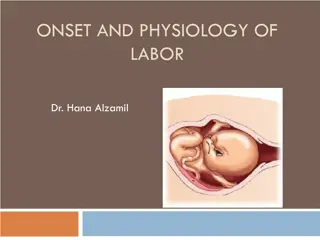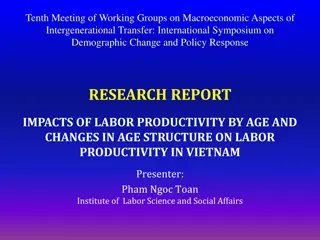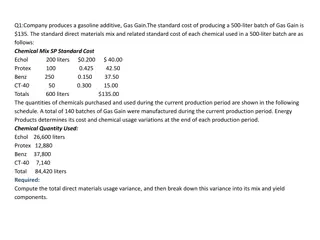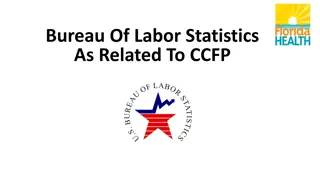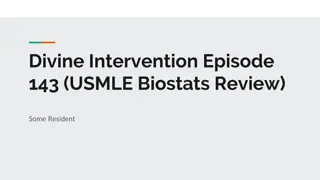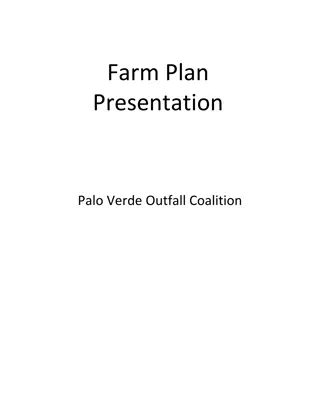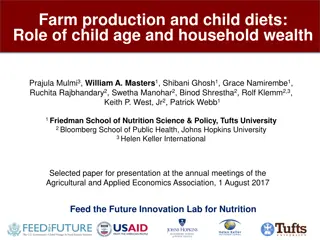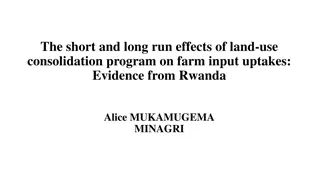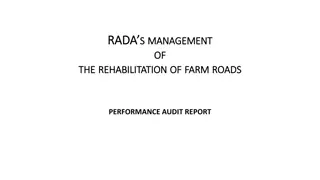U.S. Farm Sector's Sensitivity to Labor Costs and Availability
Agriculture labor is a significant expense for farmers, with a growing demand for labor that is geographically concentrated and time-sensitive. Challenges arise in the form of a challenging immigration system and increased enforcement threats. The H-2A Temporary Agricultural Worker Program serves as a potential solution for agricultural employers facing a shortage of domestic workers. Foreign-born workers, particularly in the crop sector, make up a significant portion of the workforce, with concerns over housing and age distribution. Despite rising incomes, the sector faces ongoing issues related to labor costs and availability.
Uploaded on Sep 22, 2024 | 0 Views
Download Presentation

Please find below an Image/Link to download the presentation.
The content on the website is provided AS IS for your information and personal use only. It may not be sold, licensed, or shared on other websites without obtaining consent from the author. Download presentation by click this link. If you encounter any issues during the download, it is possible that the publisher has removed the file from their server.
E N D
Presentation Transcript
U.S. Farm Sectors Sensitivity to U.S. Farm Sector s Sensitivity to Labor Costs and Availability Labor Costs and Availability Veronica Nigh American Farm Bureau Federation Ag Outlook Forum 2020
Agriculture Labor is farmers third highest expense Time-sensitive (or not) Geographically concentrated labor demand Growing pains with domestic workers Increasing farm size
Factors Outside of Agriculture Elastic demand for food Challenging immigration system with increased threat of enforcement Wage potential in U.S. H-2A Temporary Ag Worker Program
Hired Workers Increasingly Foreign-born, Unauthorized Source: National Agricultural Worker Survey (NAWS)
Like Farm Owners, the Average Farmworker Age Continues to Rise as Share of Newcomers Remains Low Source: National Agricultural Worker Survey (NAWS)
Three-quarters of farmworkers had been in the United States for at least 10 years at least 10 years Source: National Agricultural Worker Survey (NAWS)
Most Non-H-2A Crop Worker Housing Is Not Employer Provided Source: National Agricultural Worker Survey (NAWS)
Income Has Been Rising, Nearly 17% Increase Between 2007-2009 and 2015-2016 Surveys Source: National Agricultural Worker Survey (NAWS)
Enter H-2A, For Some The H-2A temporary agricultural program allows agricultural employers who anticipate a shortage of domestic workers to bring nonimmigrant foreign workers to the U.S. to perform agricultural labor or services. Employment is of a seasonal nature where it is tied to a certain time of year by an event or pattern and requires labor levels above what is necessary for ongoing operations. Employment is of a temporary nature, to last no longer than one year. The seasonal and temporary conditions of the program eliminate use of the program for much of the livestock sector. A 2009 National Milk Producers Federation study found that 62% of the nation s milk supply use immigrant labor.
Usage of the H-2A Program Continues to Climb, As Does the AEWR
National Average AEWR has Climbed by 37% Over the Last Ten Years Source: DOL
The Top States Utilizing the Program Has Remained Fairly Constant
Some Top H-2A Crops and Occupations May Be Surprising Top 25 H Top 25 H- -2A Crops and Occupations Certified, FY2016 2A Crops and Occupations Certified, FY2016 Positions Certified Primary Crops/Occupations 15,335 Fruits and Vegetables 10,066 Citrus 9,764 Squash 9,269 Livestock 8,717 Peppers 8,513 Sugarcane 7,426 Trees 7,060 Oranges 6,008 Construction of Livestock Buildings 5,893 Cucumbers 5,282 Cherries 4,836 Peaches 4,786 All Others Primary Crops/Occupations Berries Hay and Straw Apples Tobacco General Farm Worker Melons Sweet Potatoes Lettuce Nursery and Greenhouse Workers Corn Onions Tomatoes Ag Equipment Operator Positions Certified 4,538 4,530 3,749 3,582 3,494 3,435 3,340 3,030 2,977 2,713 2,572 2,539 22,287 Source: DOL
2014 AFBF Labor Study Alternative 1: Alternative 2: Alternative 3: 2A Alternative 3a: Comprehensive Reform Including a Redesigned Guest Worker Program for Agriculture Enforcement Only Enforcement with a Path to Legalization Without a Guest Worker Program Comprehensive Reform Including an Expanded H- Guest Worker Program for Agriculture
2014: Gauging the Farm Sectors Sensitivity to Immigration Reform via Changes in Labor Costs and Availability Results Comparison Factor Alternative 1: Enforcement Only Alternative 2: Enforcement with a Path to Legalization Without a Guest Worker Program Alternative 3: Comprehensive Reform Including an Expanded H2A Guest Worker Program for Agriculture Alternative 3a: Comprehensive Reform Including a Redesigned Guest Worker Program for Agriculture 15-29% 7-14% 6% <2% Net Farm Income 10-15% 5-10% 2-3% <2% Farm Asset Values 5-6% 2-3% 1-2% -- Food Prices 30-61% 13-28% 11-12% 2-3% Fruit Production 15-31% 10-22% 8-9% 2-3% Vegetable Production 1-3% 1% <1% -- Grain Production 13-27% 3-5% 3% 1-2% Livestock Production
More Specifically, Dairy Study Results: Dairy: Reduce the U.S. dairy herd by 1.34 million head, milk production by 29.5 billion pounds and the number of farms by 4,532. Retail milk prices would increase by an estimated 61%. Dairy Industry and Beyond: Eliminating immigrant labor in dairy farms would reduce U.S. economic output by $22 Billion and 133,000 workers, both immigrant and native-born, would lose their jobs. Slightly more than 50% of losses would occur in input supply sectors and services provided to dairy farms.
Thank you Veronica Nigh Economist Email: veronican@fb.org Office: 206-406-3622 www.fb.org/market-intel
















